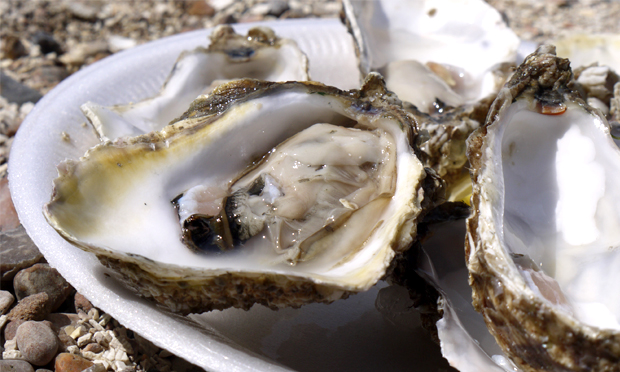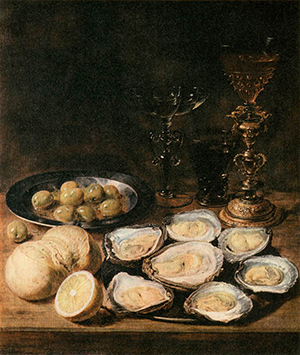Travelling on an Oyster: history, biology and some local cooking tips

“A perfectly formed sophisticated animal”: oysters plucked from their watery home. Image: Malcolm Murdoch via Flickr
A recent sighting of our normally homesick, footsore legionary had him striding up Stamford Hill bright of eye and bushy-tailed plotting a nice little import/export business.
An assignment to the garrison in Colchester, and a chance encounter in a Shoreditch pub, led to the discovery of his inner entrepreneur, and an escape from the military life to which he had never been particularly well-suited.
He already knew that British oysters were renowned for their quality, and consumed in some quantity, as seen in the thousands of shells piled up around an oyster shack at the city gate of Colchester, where legionaries would have had a last refreshment before trudging along to London, through Old Ford to Hackney Road, crossing Ermine Street at Shoreditch, and ending up at Old Street, with perhaps a deviation to the Well and Bucket where Bethnal Green Road crosses Brick Lane.
A welcome sight, as it is for us today, with its oyster counter and honest refreshments. This might have taken his mind off the thought of Boadicea with those sharp blades attached to her chariot wheels, mincing up the bodies of fallen soldiers and vanquished natives, as she attacked and destroyed Camulodunum.
Apicius, the 1st century glutton who gave his name to a later collection of recipes, had better ideas – Colchester native oysters minced and cooked lightly with sea urchins and mussels and served in a sauce of liquamen (nam pla, Thai fish sauce ), olive oil, lovage leaves, mint, coriander, cumin, pepper, and chopped roasted pine nuts.
But meanwhile the idea of exporting British oysters to Rome, and importing the universal ‘ketchup’ liquamen on the return journey, gave our friend a spring in his step. He recalled a stint at Silchester, between Basingstoke and Reading, where thousands of oyster shells were piled up in the middens to the delight of future archaeologists. How the oysters got there, so far inland, fresh and in perfect condition, is today a mystery; perhaps in barrels of seawater, swathed in seaweed, or cooled with ice or compacted snow, and stored on arrival in specially constructed ice-houses.

Luxury: detail from An Allegory of the Four Elements by Jan Bruegel
If the provincial society of Iron Age Britain could afford such luxuries, surely Rome would gladly pay even more. Of course the journey would take weeks, by which time the oysters would all be dead. But a system of pit stops, offloading the weary molluscs to rest and recuperate and fatten up a bit, in suitable surroundings in northern France, possibly Spain, as the journey proceeded by sea and land, made the transaction possible.
British oyster shells found in Rome imply success. Rome demanded nothing but the best, and Britain could supply it. Cheap at source, oysters got more costly as the journey progressed, but the return cargo was a doddle. Big amphorae of various fish sauces, liquamen and garum (a sort of ketchup, made from small salted and fermented fish like whitebait, or mackerel, sometimes including their guts), were essential to natives and Romans alike, to liven up the dreary British diet of sludge coloured porridge of grains and pulses and overcooked greens and roots.
But these condiments, unlike the poor oysters, didn’t go off during the journey, but matured and increased in value; even the dregs at the bottom of the jars made a good relish. With gratifying symmetry we can now buy versions of them in the Vietnamese supermarket Longdan on Kingsland Road, along which our hero must have trudged up North, ruminating on these fine condiments.
Biology

Alexander Adriaenssen’s Still-Life with Oysters (c. 1630) Image: Wikimedia Commons
The oyster has a complex structure and a very long history. Longer than ours. Sentient life on earth began in estuaries where nutrients in water from glaciers, lakes, rivers and bogs, trickled down to join the ebb and flow of tidal waters, rich in yet more good things, to provide the ideal environment for the emergence of life as we know it.
Oysters got there five million years before humankind poked her head above the primeval slime, aspiring to become a well-nourished hunter-gatherer, before tottering towards agriculture, politics and class warfare. The oyster was by then a perfectly formed sophisticated animal, a filter-feeder with built in reproductive and digestive systems, plumbing, sewage disposal and all the technology needed to extract, through its frilly gills, the micro-organisms, invisible to the naked eye, that flourished in the coastal bays and river mouths.
It wandered about during its carefree youth, spawning a massive brood of spat, eventually choosing a spot where the nutrients were most likely to be available and plentiful and, turning on its left side, settled down to decades of placid immobility, a life well lived and a welcome snack for passing foragers.
Way back in 1881 the biologist William K. Brooks wrote with affection (and the help of a powerful microscope) a loving account of the complex structure and behaviour of the oyster, with its manifest destiny to nourish, comfort and sustain the inhabitants of Chesapeake Bay for all time.
This was equally true for the inhabitants of Galway Bay and West Mersea, but everywhere their sad destiny became near extinction, as oysters, first a snack for foragers, then a jealously farmed commodity, hampered as well as protected by a miasma of conflicting rules and regulations, and vulnerable to disease and pollution, very nearly became extinct by the 1980s.
The Oyster Renaissance
From being associated with poverty by Charles Dickens in the 1860s, then seen as posh grub for toffs by the end of the century, the oyster has veered between the polarities of wary suspicion and manic addiction. A century later, native varieties have been nurtured back to health, and new kinds of rock oyster brought from the Pacific and Japan to be reared and harvested here and in Europe.

Banquet: Girl eating oysters (c.1660) by Jan Steen
Oysters were plentiful in seventeenth-century Holland, but still regarded as a luxury, glistening in still life paintings along with exotic lemons and hothouse grapes, or being greedily consumed by voluptuous young women, in banquet scenes (as in the Jan Steen painting tot he right.)
The Oyster Renaissance is with us in Hackney; we can enjoy them all the year round, in a variety of places, from the lovingly recreated basic East End pub, The Well and Bucket, to the elegant oyster-based menu at the Richmond, from the small Behind This Wall in Mare Street, to the Wright Bros in Spitalfield Market, and up the road in Farringdon to Hix Oyster and Chop House, with a deviation to Islington’s brasserie Bellanger. There’s the various Sutton & Sons fish and chip shops, and their fishmongers in Kingsland Road, where you can buy oysters to take home. Some of these establishments offer a Happy Hour with oysters at £1 a pop, and the pleasure of casual enjoyment, worlds away from the elitist connotations of renowned West End establishments.
Cooking techniques
Cooking with oysters seems a good idea where they are cheap and plentiful, but most Brits revert to the puritanical conviction that they should be served as simply as possible, to get the full impact of their complex flavours.
A good guide to these is available from the Shellfish Association of Great Britain, together with their recipe pamphlet, Cooking with Oysters. But it’s as well to admit that an analysis of flavours can be subjective and depend on factors that will vary depending on how the creatures have been spawned, reared, fattened and marketed.
Just never swallow them whole. Slurp, sniff, chew gently, relax and enjoy the slow unfolding of pleasurable flavours and aromas.
But careful cooking can bring out these flavours too. One could try steak pudding enhanced with the briny unctuousness of oysters, or Oysters Rockefeller (opened oysters covered in a purée of green herbs and vegetables – some of them supposed to be secret – and topped with breadcrumbs then fiercely grilled to leave the oyster still cool under its green mantle) or Angels on Horseback: oysters wrapped in bacon and grilled (it all depends on the bacon, it has to be dry enough to crisp quickly so the oyster doesn’t overcook). Our resources in Stokey, Meat N16 and Sutton and Sons are a help here.
Drew Smith’s version of oyster soup involves finely sliced leeks and carrots softened in butter, simmered in white wine with some parsley, then allowed to rest with shucked oysters and their juices then, much later, served warmed through with some spinach and cream and yet more oysters.
No messing around; as he says: “Oysters are their own seasoning.”
